A.
Access Sign. A freestanding or building-mounted sign that is located within ten (10) feet of the street right-of-way and within ten (10) feet of a curb cut or other vehicular accessway to a lot.
Accessory Structure. A subordinate structure, the use of which is incidental to and customarily associated with the principal structure's use and which is located on the same lot or adjacent lot as the principal structure and principal use.
Accessory Use. A subordinate use which is incidental to and customarily associated with the principal use and which is conducted on the same lot or adjacent lot as the principal use.
Addiction Treatment Facility. Any building, structure, or space whose principal or primary function is the reception, housing, and/or care of chemically dependent adults and/or their minor children, and/or by which distribution of synthetic narcotics or any other method attempts to control, suppress, and/or eliminate a person's mental or physical dependence on any illegal or harmful substance.
Adult Book Store. An establishment having as a substantial or significant portion of its stock in trade, books, magazines, and other periodicals which are distinguished or characterized by their emphasis on matter depicting or relating to "specified sexual activities" or "specified anatomical areas" as herein defined or an establishment with a segment or section devoted to the sale or display of such material.
Adult Mini Motion Picture Theater. A facility with a capacity for less than fifty (50) persons, used for presenting material distinguished or characterized by an emphasis on matter depicting, describing or relating to "specified sexual activities" or relating to "specified anatomical areas" for observation by patrons therein.
Adult Motion Picture Theater. A facility with a capacity of fifty (50) or more persons used for presenting material distinguished or characterized by an emphasis on matter depicting, describing or relating to "specified sexual activities" or "specified anatomical areas" for observation by patrons therein.
Adult Entertainment Business. Any establishment involved in the sale or services of products characterized by the exposure or presentation of "specified anatomical areas" or physical contact of live males or females, and which is characterized by salacious conduct appealing to prurient interest for the observation or participation in by patrons. Services or products included within the scope of adult entertainment business are photography, dancing, reading, massage and similar functions which utilize activities as specified above.
Adult Use. A principal use involving the sale of adult goods or services. Adult uses consist of adult entertainment businesses, such as adult book stores, adult mini motion picture theaters, and adult motion picture theaters.
Agent. An authorized representative of an applicant.
Agriculture. See the definition of agricultural activities in the Ohio Revised Code, Section 1.61, excluding Large and Major Farms. Agriculture also includes agritourism uses, as defined by the Ohio Revised Code, Section 901.80.
Air Transport Services. A principal use consisting of the use of aircraft to transport goods or persons. Air transport services include airports. Airport designers and administrators and logistics brokers are considered professional services uses.
Alley or Alleyway. A public or private right-of-way of a width of twenty (20) feet or less, which provides secondary access to property(s) abutting such alley.
Alteration. Any action that changes the height, size, or shape of a structure or any action that affects the structural supports of a sign.
Animal Care. A principal use, other than agriculture, consisting of the housing, training, exercising, and/or providing medical services for large and small animals, including any outside runs, kennels, or training areas.
Animated Sign. Any attention-diverting apparatus, equipment or devices in a sign that uses movement or change of lighting to depict action or create a special effect or scene. Animated signs shall include: blinking, coursing, flashing, moving, racer-type, rotating, revolving, spinning, and other similar types of apparatus, equipment or devices. (See "electronic message" and "flashing" signs.)
Antenna. Any transmitting or receiving device used in communications that radiate or capture electromagnetic waves, digital signals, analog signals, radio frequencies, wireless communications signals, or other communication signals.
Antenna Support Structure. Any building or structure other than a tower which can be used for the location of wireless communications facilities.
Appeal. A request for review of the interpretation of the Building Officer or their designee or the Planning Commission of any provision of this Zoning Code.
Applicant. The owner or authorized representative of a lot that is requesting a permit, variance, or other permission from the City.
Architect. An architect registered by the State of Ohio.
Arterial Street. A street that accommodates traffic to and from an expressway or to or through major commercial districts and that generally experiences traffic volumes exceeding 10,000 ADT.
Artisan Manufacturing. The preparation, display, and/or sale of individually crafted products, such as artwork, jewelry, furniture, sculpture, pottery, leathercraft, hand-woven articles, food products and related items in an establishment not exceeding 3,000 square feet of GFA per lot.
Arts, Science, and Cultural. A principal use consisting involving the advancement of art, science, or culture and the delivery of art, science, or culture to the general public, such as museums, ballets, and theaters. Arts, science, and cultural uses do not have a central mission to sell products or services for profit and do not, therefore, include art vendors, for-profit fabrication studios, or dance lesson studios that are not in association with a not-for-profit dance company.
Automotive Sales. A principal use consisting of the selling or leasing of personal vehicles, including cars, light trucks and SUVs, motorcycles, RVs, ATVs, motorized recreational equipment, and motorized watercraft, new and used.
Automotive Services. A principal use consisting of the commercial care of personal automobiles and light trucks, including repair, cleaning, maintenance, and refueling. Deliveries of parts and towing of vehicles may occur daily, but heavy truck traffic is infrequent and typically limited to refueling and delivery of fuel. Facilities for heavy truck repair are considered commercial services uses.
Average Grade. The lower of:
(a) Existing grade prior to construction; or
(b) The newly established grade after construction, exclusive of any filling, berming, mounding, or excavating solely for the purpose of locating or increasing the height of a sign or fence.
Awning. A permanent roof-like cover, often of fabric, metal, or glass, which projects from a wall or roof of a structure over a window, walkway, doorway, or the like and is designed and intended for protection from the weather or as a decorative embellishment. An awning is not differentiated from a canopy.
Awning Sign. A sign located on an awning.
B.
Basement. A story having more than one-half (½) of its height below the average grade.
Bench Sign. A sign located on the seat or back of a bench placed on or adjacent to a public right-of-way.
Block. All or part of one (1) side of a street between two (2) intersecting streets.
Board. See Board of Zoning Appeals.
Board of Zoning Appeals. The Board of Zoning Appeals of Portsmouth, Ohio, or, if a board of zoning appeals is not active in the City, the Planning and Zoning Commission of Portsmouth, Ohio.
Bond. Any form of security, including cash deposit, surety bond, collateral, property, or instrument of credit, in an amount and form satisfactory to Council.
Buffer. An undeveloped easement area that lies at the periphery of a lot and insulates the negative effects of one property from impacting a neighboring property or district.
Building. Any structure with substantial walls and roof securely affixed to the land, and which is entirely separated on all sides from any similar structure by space or by walls in which there are no communicating doors, windows, or similar openings.
Building Officer. The staff person or their designee responsible for the administration and enforcement of the Zoning Code for the City.
C.
Canopy. See Awning.
Cemetery. Land used or intended to be used for the burial of the dead and dedicated for cemetery purposes including mausoleums, but excluding crematoriums and funeral establishments. Depending on the size of the use, a cemetery is considered either a Medium Outdoor Recreation or a Small Outdoor Recreation use.
Certificate of Deposit. A certificate held on deposit by a financial institution for the City under such time as a subdivider has fulfilled their obligation to install any required improvements.
City. Of or relating to the City of Portsmouth, Ohio, and its administration.
City Administrator. The staff administrator of municipal operations for the City.
Commercial Sales. A principal use consisting of the sale or leasing of goods to other businesses rather than directly to household consumers. Examples of commercial sales include the selling of raw materials, equipment, office furniture, and commercial vehicles.
Commercial Services. A principal use that provides services to other companies rather than directly to household consumers. These services typically involve the arrival and departure of heavy trucks more than once per day. Examples of commercial services are farm equipment rental services, machinery repair services, and commercial linen laundering. A crematorium is considered a commercial services use.
Commission. See Planning and Zoning Commission.
Comprehensive Plan. A central organizing document for planning and managing growth.
Connection. A sidewalk and/or bike path that links neighborhoods to other neighborhoods, schools, parks, and other destinations.
Conservation Area. An area designated by the Planning and Zoning Commission, the current comprehensive plan, or another officially adopted planning document as an area where development should not occur due to the area's environmental, aesthetic, social, or cultural significance to the City.
Conservation Easement. A nonpossessory interest in real property imposing limitations or affirmative obligations, the purposes of which include retaining or protecting agricultural, natural, scenic, or open space values of real property; protecting natural resources; or maintaining air or water quality.
Conservation Recreation. A principal use that preserves natural habitat or recreates natural communities in outdoor settings. Associated educational interpretation, trails, and shelters are included in conservation recreation uses. Examples of conservation recreation uses include arboreta, preserves, scenic river corridors, and hiking areas.
Construction Plans. The maps or drawings accompanying a subdivision plat and showing the specific location and design of improvements to be installed in a subdivision.
Cooperative Dwelling. A type of residential use, differentiated from dwelling, as defined in the City of Portsmouth Housing Code. If no definition is provided in the City of Portsmouth Housing Code, a cooperative dwelling shall be defined as: a structure that is arranged, designed and intended to house multiple individual residents, and not a single-family or multiple-families, with shared kitchen and bathroom facilities and a shared living space; each resident has access to their own sleeping room and the number of occupants shall not exceed provisions set forth in the City of Portsmouth Housing Code.
Corner Lot. A lot abutting upon two (2) or more streets at their intersections, or upon two parts of the same street, and in either case forming an interior angle of 135 degrees or less as measured at the center line of the road or the interior right-of-way line as applicable.
Council. The legislature of the City.
Crematorium. A use containing properly installed, certified apparatus intended for use in the act of cremation. A crematorium is considered a commercial services use.
D.
Development. Construction, reconstruction, conversion, structural alteration, relocation or enlargement of any structure; the construction, expansion or modification of any parking areas, loading areas, access drives or other paved surfaces; any mining, excavation, landfill or other modification of the natural landscape; any changes to approved landscape plans including plant materials, grading, walls, or fences.
District. A distinct geographic area of the municipality wherein regulations of the Zoning Code are uniformly applied. For the purposes of this Zoning Code, the term district is used synonymously with the term zone.
Double-frontage Lot. A lot with frontage on more than one street. Double-frontage lots include corner lots and through-lots.
Driveway. Any unenclosed motor vehicle pathway that (a) does not exceed ten (10) feet in width or the width of the garage to which it leads, whichever is greater, and (b) in the shortest distance practicable, provides a vehicular path from a street right-of-way to a private garage or to an area to the side or rear of the principal structure.
Dwelling. A structure or part of a structure that is used as a home, residence, or sleeping place by one (1) person who maintains a household or by two (2) or more persons who maintain a common household. A cooperative dwelling is differentiated from a dwelling; see the definition of a cooperative dwelling.
Dwelling Unit. A room or group of rooms occupied as separate living quarters or, if vacant, intended for occupancy as separate living quarters. Separate living quarters are those in which the occupants live and eat separately from any other persons in the building and which have direct access from outside the building or through a common hall.
E.
Earth-disturbing Activity. Actions taken to alter the existing vegetation and/or underlying soil of site, such as clearing, grading, site preparation (e.g., excavating, cutting, and filling), soil compaction, and movement and stockpiling of top soils.
Easement. The right to use the real property of another owner for a specific purpose. The easement is itself a real property interest, but legal title to the underlying land is retained by the original owner for all other purposes.
Electronic Message Sign. A sign with a fixed or changing display or message, wherein the sequence of message and the rate of change is electronically programmed and can be modified by electronic process.
Emergency Medical Care. A principal use consisting of services provided by medical personnel that include emergency room care, trauma care, or overnight care. Emergency ambulance services may frequently visit emergency medical care uses.
Engineer. The staff engineer of the City.
Environmental Impact Statement. A detailed analysis of the environmental consequences of a project or proposed action as required by the U.S. Environmental Protection Agency or the Ohio Environmental Protection Agency.
Equipment Shelter or Equipment Cabinet. The structure in which the electronic receiving and relay equipment or other necessary equipment for a wireless communications facility is located.
Escrow. A deposit of cash with the City in lieu of an amount required and still in force on a performance or maintenance bond.
Excavation. The removal or recovery by any means of soil, rock, mineral substances, or organic substances other than vegetation, from on or beneath the surface of water or land.
External Illumination. A sign illumination technique that uses light sources outside of the sign face that project light towards or across the sign face. An example of external illumination is gooseneck lighting.
F.
Family Care Services. A principal use that provides human services related to child day care, adult day care, or funeral services, and where customers are not overnight residents of the property. Funeral homes are considered family care services, except when crematory services are provided, in which case the funeral home is considered a commercial services use. Addiction treatment facilities are not considered family care services.
FCC. The U.S. Federal Communications Commission and any legally appointed, designated, or elected agent or successor.
FEMA. Federal Emergency Management Agency; the agency with the overall responsibility for administering the National Flood Insurance Program.
Fence. A constructed barrier of wood, masonry, stone, wire, metal, or other manufactured material or combination of materials erected to enclose, screen, or otherwise separate areas of land, including agricultural fences.
Flag. A fabric, banner, or bunting containing distinctive colors, patterns or symbols, used as a symbol of a recognized government or political subdivision, corporation, lodge, fraternity or sorority, political party, nonprofit organization, charity, club, association or other similar entity.
Flag Sign. A flag that conveys a message other than representing a recognized government or political subdivision.
Flashing Sign. A sign, the illumination of which is not constant in intensity when in use, and which exhibits sudden or marked changes in lighting effects.
Footprint. The outline of the total area covered by a structure or paved area's perimeter at the ground's surface.
Freestanding Sign. A sign that is attached to, erected on, or supported by some structure, such as a post, mast, or frame that is not itself an integral part of or attached to a building or other structure whose principal function is something other than support of a sign.
Frontage. That portion of a lot abutting on a dedicated street right-of-way.
Front Lot Line. A lot line that separates a lot from a street right-of-way.
 |
Front Setback. The shortest horizontal distance between the front lot line and any portion of a structure on the lot.
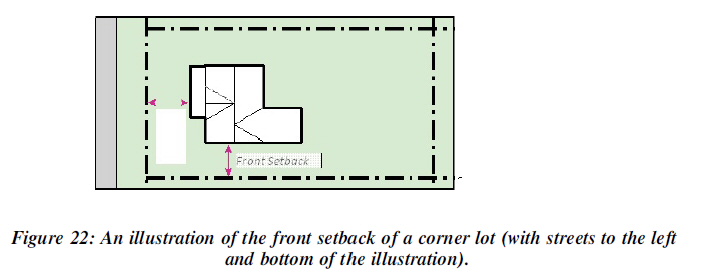 |
Front Setback Line, Minimum. A line formed by connecting points, where each point is internal to the lot and distanced from the front lot line by the minimum required front setback.
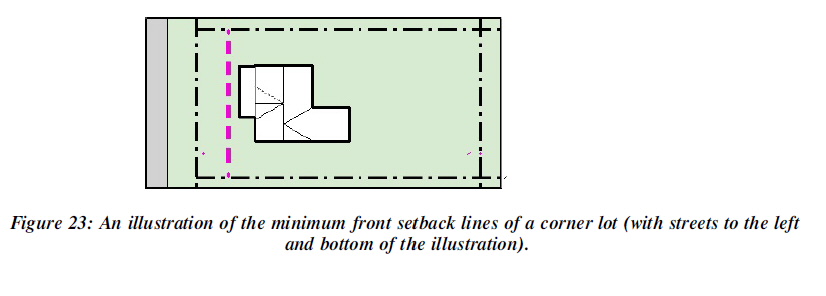 |
Front Yard. Any undeveloped area of a lot that has a setback from the front lot line equal to or less than X, where X equals the distance between a front lot line and the most distant point of a front facing exterior wall of a principal structure, measured perpendicularly from the front lot line. For this definition, a front facing exterior wall is any wall that is within sixty (60) degrees of parallel of a front lot line.
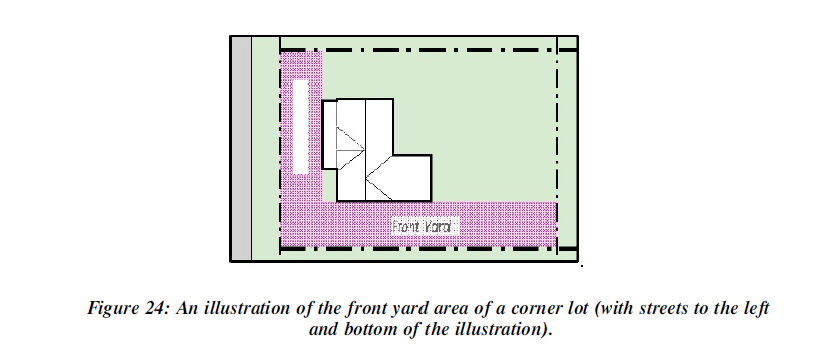 |
Funeral Home. A principal use consisting of undertaking services, such as preparing the dead for burial, and arranging and managing funerals. Typical uses include funeral homes or mortuaries. Funeral homes are considered family care services, except when crematory services are provided, in which case the funeral home is considered a commercial services use.
G.
General Personal Services. A principal use that provides services for a person's everyday functions in spaces of less than 3,000 square feet of floor area. These services include salons, spas, laundromats, dry cleaners, shoe repair, physical fitness centers, and dance studios, martial arts studios, art education centers, and electronics repair. Heavy truck shipments to the location of general personal services uses are infrequent.
GFA. Gross floor area, or the total number of square feet of floor area within the outside line of walls and including the total of all space on all floors of a building, including porches and garages, but not including space in a basement or cellar when the basement or cellar space is used only for storage or incidental uses, and not including floor space with less than seventy-eight (78) inches of vertical clearance.
Government Administration. A principal use that provides office space, hearing chambers, waiting rooms, and other facilities for administering government responsibilities, such as legal services, planning services, resource protection administration, education programming administration, and emergency management services, but not including police and fire stations.
Government Services. A principal use consisting of government service distribution, such as road salt storage, animal rescue centers, correctional facilities, vehicle maintenance and storage, police stations, fire stations, and emergency medical services dispatch stations, and their associated garages, offices, grounds, boarding halls, and sleeping facilities. Government services do not include schools.
Grade. The slope of any surface, specified in percent grade terms, where percent grade is the ratio of vertical elevation change over horizontal distance multiplied by 100. Grade may also mean Average Grade.
Ground Level. See Street Level.
Ground Transport Services. A principal use involving the use of trains, trucks, or buses to transport goods or persons. Ground transport services include truck depots, train stations, and bus stations, but not taxi depots or car rental centers. Ground transport services do not include the storage of goods to be transported and, therefore, do not include warehouses, which are considered light industrial uses.
H.
Hazardous Sign. Any sign or sign support structure that is structurally or electrically unsafe, as determined by the City.
Heavy Industrial. A principal use consisting of an establishment engaged in manufacturing, assembly, fabrication, packaging, or other industrial processing of products primarily from extracted or raw materials or the bulk storage and handling of such products and materials, or an industrial establishment having potential to produce noise, dust, glare, odors or vibration beyond its property line. This term includes but is not limited to: (a) processing and packaging; (b) chemical manufacturing; (c) stonework or concrete product manufacturing; (d) fabrication of metal products; (e) manufacturing of agricultural, construction, or mining machinery; (f) motor vehicle manufacturing; (g) lumber milling; (h) ship or boat construction (i) permanent concrete/batch plant.
Home Occupation. An accessory use of a dwelling unit for legitimate businesses, professions, trades or vocations conducted within an enclosed dwelling unit, which is clearly incidental and accessory to residential occupancy and does not change the residential character thereof.
I.
Impervious Coverage. The percent of the lot's horizontal plane that is occupied by impervious, man-made materials, including, but not limited to, buildings, asphalt, concrete, swimming pools, barns, and carports, but excluding porous pavement, permeable pavers, decks with gaps between decking for drainage, lawn grasses, gardens, and other landscaping.
Indoor Recreation or Leisure. A principal use that includes indoor leisure and recreation uses of more than 3,000 square feet but smaller than 50,000 square feet, such as skating rinks, gymnastics studios, dance studios, boxing clubs, bowling alleys, large physical fitness centers, and cinemas. Indoor recreation or leisure uses also include organization and membership club centers that are meeting areas for the membership of fraternal organizations, political organizations, and business organizations. Up to fifty percent (50%) of the floor area of an indoor recreation or leisure use may be used as the offices of administrators associated with the use. Physical fitness centers smaller than 3,000 square feet are categorized as general personal services uses.
Interior Lot. A lot that has only one (1) street frontage.
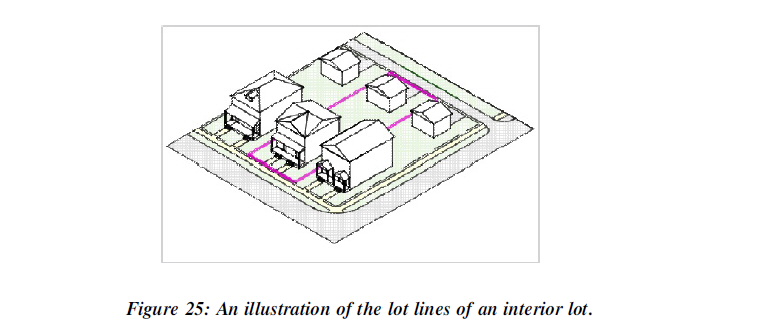 |
Internal Illumination. A sign illumination technique involving a light source that is located either in the interior of the sign so that the rays go through the face of the sign or the sign's letters or symbols, or which is attached to the face of the sign and is perceived as a design element of the sign.
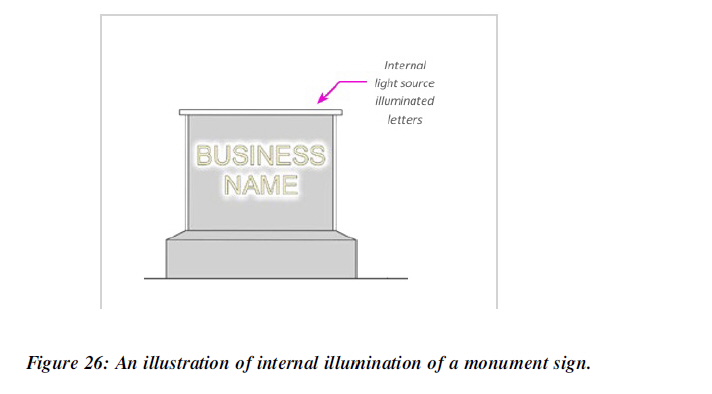 |
Irregular Lot. A lot that is not rectangular.
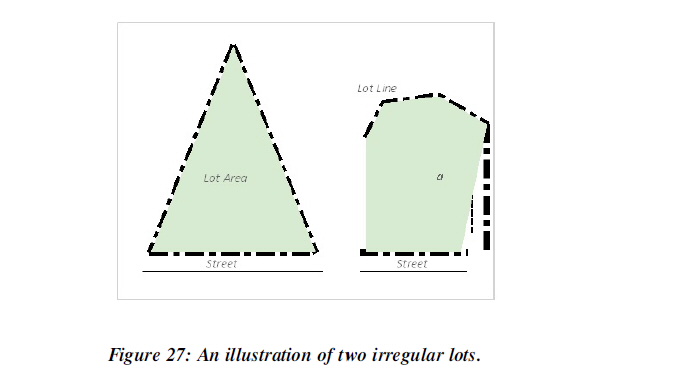 |
J.
None.
K.
None.
L.
Landscape Architect. A landscape architect registered by the State of Ohio.
Large Light Industrial. A principal use consisting of an establishment engaged in the indoor warehousing, manufacturing, assembly, fabrication, packaging or other industrial processing of finished parts or products, primarily from previously prepared materials, or the indoor provision of industrial services, where there are few external effects across property lines. This term includes but is not limited to a business engaged in the processing, fabrication, assembly, treatment, or packaging of food, textile, leather, wood, paper, chemical, plastic, or metal products, but does not include basic industrial processing from raw materials. Large light industrial uses have principal structures of 25,000 square feet or more per lot. Renewable energy generation systems with 25,000 square feet of structure or more per lot are considered large light industrial uses.
Large Lodging. A principal use involving a building or a part of a building in which guest rooms are offered for public hire to any individual(s) for no more than thirty-five (35) days in a calendar year, and where a general kitchen and dining room may be provided within the building or in any accessory building. A large lodging is differentiated from a small lodging use in that a large lodging use exceeds 5,000 square feet of GFA per lot or has more than eight (8) guest rooms per lot.
Large Outdoor Recreation. A principal use that attracts large volumes of visitors in an outdoor setting, has an occupancy capacity of more than 20,000 persons, and may induce high volumes of traffic, light, and/or noise. Examples of large outdoor recreation uses include commercial water parks, regional amusement parks, professional or collegiate sports venues, and outdoor music venues.
Large Retail. A principal use consisting of the selling or leasing of goods directly to household consumers in retail spaces exceeding 5,000 sq. ft. of GFA per lot. For the purposes of calculating GFA for this definition, retail units in attached structures that straddle lot lines and under common ownership or management shall be calculated as being located on the same lot. Large retail includes, but is not limited to, the selling or leasing of clothing, unprepared food, home goods and furnishings, collectibles and antiques, electronics, non-motorized recreation equipment, art and décor, pets and pet care products, and appliances.
Large Surface Parking. A principal or accessory use consisting of an off-street, ground-level area improved for the temporary storage of motor vehicles and in excess of 5,000 square feet per lot.
Library. A principal use consisting of a public, nonprofit facility in which literary, musical, artistic, or reference materials such as but not limited to books, manuscripts, computers, recordings, or films are kept for use by or loaning to patrons of the facility, but are not normally offered for sale.
Litter. Garbage, trash, waste, rubbish, ashes, cans, bottles, wire, paper, cartons, boxes, automobile parts, furniture, glass or anything else of an unsightly or unsanitary nature.
Local Street. A street intended to provide access to other streets from individual properties, generally bearing a volume of traffic no greater than 800 ADT.
Lot. A tract, plat, or portion of a subdivision or other parcel of land intended as a unit for the purpose, whether immediate or future, of transfer of ownership or for a building development.
Lot Frontage. The aggregate length of all front lot lines.
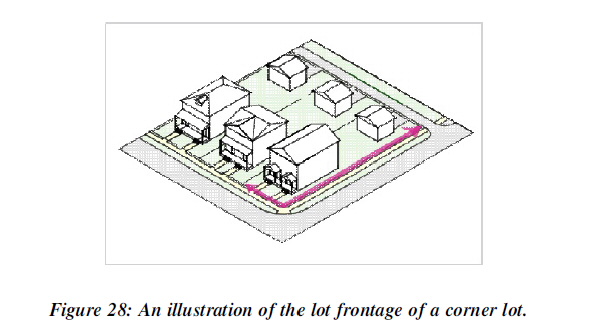 |
Lot Line. The bounding line that separates a lot from another lot or from a right-of-way.
M.
Major Collector Street. A street which carries traffic from the minor collector system to an arterial street and that generally experiences traffic volumes of less than 10,000 ADT.
Manufactured Home. A generic term that describes housing that is manufactured in a factory rather than on-site according to the Manufactured Home Construction and Safety Standards (HUD Code).
Mayor. The Mayor of the City.
Medium Outdoor Recreation. A principal use that provides opportunities to play and relax on lots larger than two (2) acres or with more than eight (8) parking spaces but with occupancy capacities of fewer than 20,000 persons. Such uses may include disc golf courses, golf courses, non-professional and non-collegiate sports fields, regional beaches, large pools, and sledding hills. Cemeteries of more than two (2) acres are considered medium outdoor recreation uses.
Menu Board Sign. A ground-mounted sign displaying the bill of fare for a restaurant, drive-in or drive-thru restaurant, or instructions or services for other drive-thru establishments.
Minor Collector Street. A street that carries internal traffic within a neighborhood, connects local streets to major collector streets or to arterial streets and that generally experiences traffic volumes of less than 4,000 ADT.
Minor Subdivision. Any subdivision involving no more than five (5) lots after the original tract has been completely subdivided, all of the lots of which front on an existing street and with which there is no new street or right-of-way required or proposed.
Mobile Home. A structure, transportable in one or more sections, which is at least eight (8) feet in width and thirty-two (32) feet in length, which is built on a permanent chassis and designed to be used as a dwelling unit, with or without a permanent foundation when connected to the required facilities.
Mobile Sign. A sign attached to, mounted to, pasted, painted or drawn on any vehicle, whether motorized or pulled, that is placed, parked or maintained at one particular location for the express purpose and intent of promotion or conveying an advertising message.
Monopole. A support structure constructed of a single, self-supporting hollow metal tube securely anchored to a foundation.
N.
Neighborhood Agriculture. A use involving agricultural activities, as defined by the Ohio Revised Code Section 1.61, provided that the activities are limited to one (1) acre per lot.
O.
ODOT. The Ohio Department of Transportation.
OEPA. The Ohio Environmental Protection Agency.
Open Space. Land reserved from development as a relief from the effects of urbanization. It is often intended to be used for passive recreation purposes, but it may also include pedestrian plazas or active recreation areas.
Outdoor Storage. The storage of any material for a period greater than twenty-four (24) hours, including items for sale, lease, processing, and repair (including vehicles) not in an enclosed building.
P.
Parking Area. Any all-weather, dustless surface used or intended to be used for the temporary storage of a motor vehicle.
Parking Space. The area required for parking one (1) automobile, not including drive aisles.
Permanent Foundation. (1) A full, poured concrete or masonry foundation; (2) a poured concrete frost wall or a mortared masonry frost wall, with or without a concrete floor; (3) a floating slab for which the municipality may require an engineer's certification if it is to be placed on soil with high frost susceptibility; and (4) any foundation which, pursuant to the building code of the municipality, is permitted for other types of dwellings.
Permanent Sign. A sign affixed to a structure or embedded in the ground whose principal supporting structure is intended, by design and construction, to be used on a permanent basis.
Pick-up Window. An opening in a building, including windows, doors, chutes, or mechanical devices, through which occupants of a motor vehicle or persons on foot are passed or otherwise receive or obtain a product or service.
Planning and Zoning Commission. The Planning and Zoning Commission of the City.
Pole Sign. A permanent freestanding sign that is mounted on one (1) or more poles or other support so that the bottom edge of the sign face is six (6) feet or more above the grade.
Principal Structure. A building or other structure that is designed for or occupied by a principal use.
Principal Use. A use that is the primary function of land or structure(s) on a lot.
Private Street. A privately owned strip of land providing access to abutting properties, but not a driveway.
Professional Services. A principal use involving professional activities in an office setting, where shipments from heavy trucks are rare, the majority of the persons on site are employees, and work schedules are typically day-time. Professional services do not include the storage, processing, testing, or production of materials that may pose a threat to nearby residential or commercial uses, such as materials that are carcinogenic, flammable, explosive, or unstable, other than those in quantities customarily found in personal computing equipment and office settings. Professional services include, but are not limited to, financial services, such as insurance and banking firms, realtors, travel agents, engineers, pet trainers, and consultants. Professional services also include medical office services but not those that provide emergency medical care or in-patient services nor those that are considered addiction treatment facilities.
Projecting Sign. Any permanent building sign attached perpendicular to a building wall and extending laterally more than twelve (12) inches but not more than forty-eight (48) inches from the face of such wall.
Q.
None.
R.
Rear Lot Line. Any lot line that does not intersect with a front lot line.
Rear Setback. The shortest horizontal distance between a rear lot line and any portion of a structure on the lot.
Rear Yard. Any undeveloped area of a lot that has a setback from a front lot line equal to or more than X, where X equals the distance between a front lot line and the most proximal point of a rear facing exterior wall of a principal structure, measured perpendicularly from the front lot line. For this definition, a rear facing exterior wall is any wall that is more than 120 degrees off of parallel of all front lot lines.
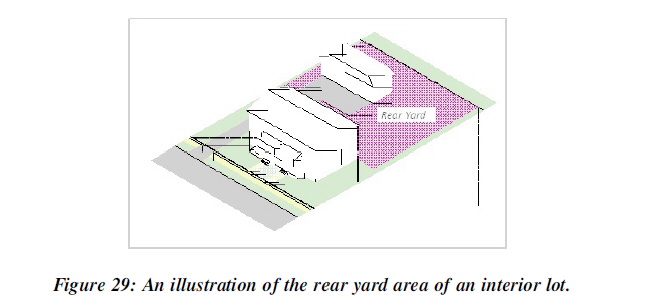 |
Recreational Lodging. A principal use that allows for the lodging of guests in tents, cabins, or recreational vehicles, where each guest may not stay for not more than 180 consecutive days, including associated sales of camping-related sundries, laundry services, and equipment rental.
Redevelopment. See Alteration.
Religious Place of Worship. A principal use consisting of a building, together with its accessory buildings and uses, where persons regularly assemble for religious purposes and related social events and which building, together with its accessory buildings and uses, is maintained and controlled by a religious body organized to sustain religious ceremonies and purposes.
Renewable Energy Generation System. An accessory use that consists of mechanical equipment for the production of energy. An example of a renewable energy generation system is an array of solar panels mounted to the roof of a dwelling or commercial building. When a renewable energy generation system acts as a principal use, it shall be considered a small-scale light industrial use or a large-scale light industrial use.
Restaurant or Bar. A principal use consisting of the preparation and on-premise sale of food and/or beverages.
Right-of-way. A strip of land occupied by or intended to be occupied by a street, crosswalk, walkway, bikeway, or other public improvement relating to public travel or access.
Roof Sign. A sign that is mounted on the roof of a building or that is wholly dependent upon a building for support and projects above the highest point of a building.
S.
School. A principal use consisting of an educational institution providing instruction for children or other degree-seeking students and including accessory facilities traditionally associated with a program of study. This definition applies to facilities that are owned and operated privately or publicly, not-for-profit or for- profit, and that do offer or do not offer a complete educational curriculum (e.g., beauty school, modeling school).
Setback. The shortest horizontal distance between a lot line and a structure on the lot.
Setback Line. A line parallel to the relevant lot line (front, back, and side) and spaced from such lot line by the minimum required setback distance. Where no minimum front, side, or rear setback is specified, the setback line shall be coterminous with the corresponding lot line.
Side Lot Line. Any lot line that is not a front lot line and does intersect with a front lot line.
Side Setback. The shortest horizontal distance between a side lot line and a structure on the lot.
Side Yard. Any undeveloped area of a lot that has a setback from a front lot line of more than X and less than Y, where X equals the distance between a front lot line and the most distant point of a front facing exterior wall of a principal structure, and where Y equals the most proximal point of a rear facing exterior wall of a principal structure, measured perpendicularly from the front lot line. For this definition, a front facing exterior wall is any wall that is less than sixty (60) degrees off of parallel of a front lot line, and a rear facing exterior wall is any wall that is more than 120 degrees off of parallel of all front lot lines.
 |
Sight Triangle. The horizontal and vertical areas at the intersections of streets and/or driveways which must remain unobstructed in order to ensure that drivers can see traffic and pedestrians around the corner of the intersection, entrance or driveway.
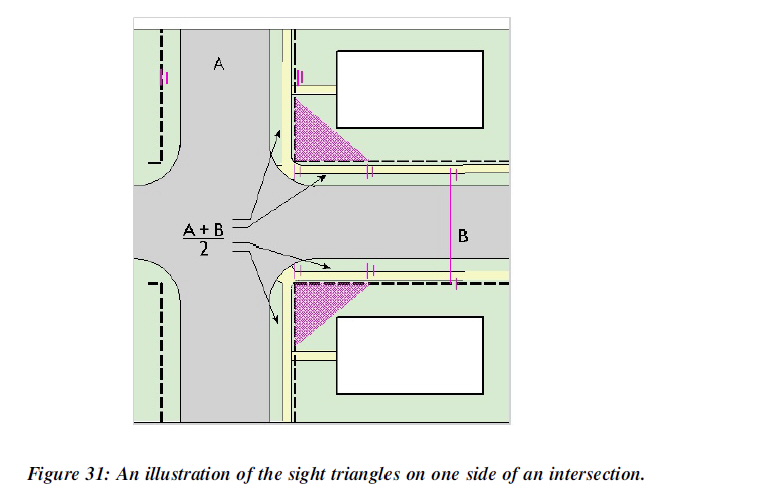 |
Sign. Any device, fixture, placard, or structure that uses any color, form, graphic, illumination, symbol, or writing to advertise, announce the purpose of, identify the purpose of a person or entity, or to communicate information of any kind.
Sign Area. The entire face of a sign including the advertising surface and any framing, trim, or molding, but not including the supporting structure.
(a) Any frame, material, or color forming an integral part of the display or used to differentiate a sign from the background against which it is placed shall count toward the maximum permitted sign area. For example, if a wall sign is painted with background colors and/or graphics integral to the overall graphic scheme of a sign, the entire wall shall be considered a sign and its measurement computed as such. If a sign is painted on a wall, and the sign can be logically separated and measured separately from the background graphics, the background graphic scheme shall not be computed in the sign area.
(b) Necessary supports or uprights on which a sign is placed are excluded from the computation of sign area.
(c) The permitted actual area of a sign shall apply to each facing of a sign structure; however, where signs are double-faced, placed back-to-back, or in a "V-type" construction when the "V" is at a forty-five (45)-degree angle or less, only one (1) side of the sign shall be counted. Back-to-back signs must be enclosed within the same cabinet or affixed to the same pole or structural support and not separated by more than two (2) feet to qualify under this section.
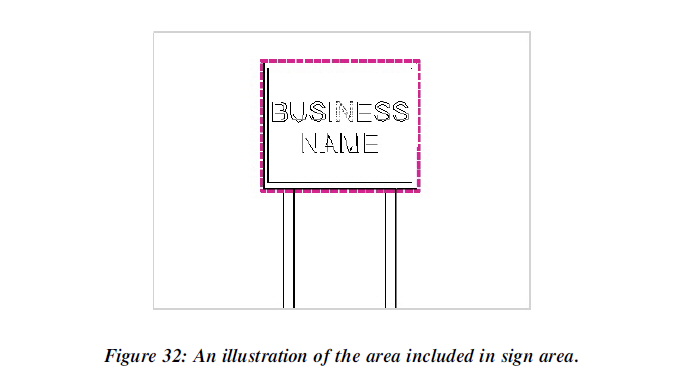 |
Sign Clearance. The vertical distance between the surface of a public walkway, bikeway, or street, and the lowest point on a sign or any sign support structure directly above such public walkway, bikeway, or street.
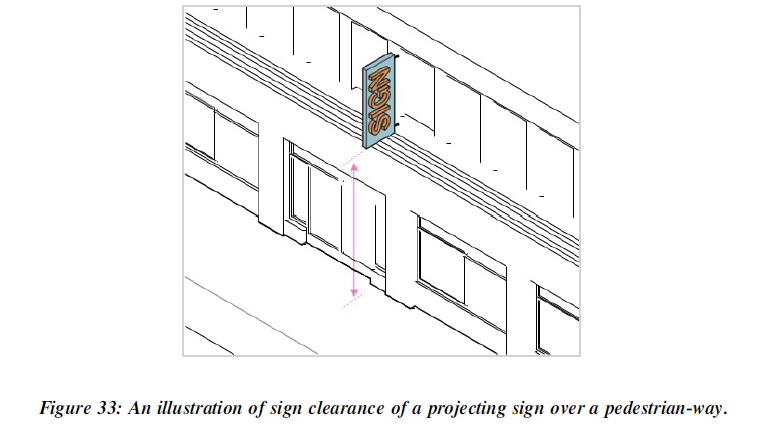 |
Sign Content Height. The vertical distance between the lowest point on a sign, not including the supporting structure, and the highest point on a sign, not including the supporting structure.
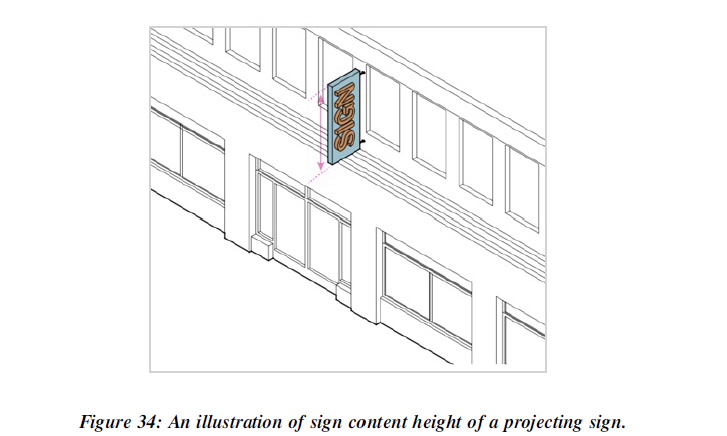 |
Sign Height. The vertical distance measured from the lowest adjacent grade to the highest point of the sign or sign structure. The overall height of a freestanding sign shall be computed as the distance from the base of the sign support structure at average grade to the top of the highest attached component of the sign. In cases in which the average grade cannot reasonably be determined, sign height shall be computed on the assumption that the elevation of the grade at the base of the sign is equal to the elevation of the nearest point of the crown of a public road or the grade of the land at the primary entrance to the lowest principal structure on the lot, whichever is lower.
 |
Significant Modification. Any development, other than cosmetic or decorative, or any change in the structural members of buildings, such as bearing walls, columns, beams, or girders, that changes the footprint or height of a structure or its associated paved areas.
Small Light Industrial. A principal use of a lot consisting of an establishment engaged in the indoor warehousing, manufacturing, assembly, fabrication, packaging or other industrial processing of finished parts or products, primarily from previously prepared materials, or the indoor provision of industrial services, where there are few external effects across property lines. This term includes but is not limited to a business engaged in the processing, fabrication, assembly, treatment, or packaging of food, textile, leather, wood, paper, chemical, plastic, or metal products, but does not include basic industrial processing from raw materials. Small light industrial uses have principal structures of less than 25,000 square feet per lot.
Small Lodging. A principal or accessory use consisting of a structure of no more than 5,000 square feet in which eight (8) or fewer rooms are rented to paying transients or travelers on a per-night, per-weekend, or per-week basis.
Small Outdoor Recreation. A principal use that provides small outdoor parks for play and relaxation within walking distance of residential neighborhoods, on a lot of under two (2) acres in size, and with no more than eight (8) off-street parking spaces. This use includes playgrounds, pocket parks, parklets, basketball courts, tennis courts, small pools, and promenades. Cemeteries of two acres or less and with no more than eight (8) parking spaces are considered small outdoor recreation uses.
Small Retail. A principal use consisting of the selling or leasing of goods directly to household consumers in retail spaces up to 5,000 sq. ft. of GFA per lot. For the purposes of calculating GFA for this definition, retail units in attached structures that straddle lot lines and are under common ownership or management shall be calculated as being located on the same lot. Retail includes, but is not limited to, the selling or leasing of clothing, unprepared food, home goods and furnishings, collectibles and antiques, electronics, non-motorized recreation equipment, art and décor, pets and pet care products, and appliances.
Small Surface Parking. A principal or accessory use consisting of an off-street, ground-level area improved for the temporary storage of motor vehicles and not exceeding 5,000 square feet per lot.
Solicitor. The Solicitor of the City.
Specified Anatomical Areas. The less than completely and opaquely covered human genitals, pubic region, buttock, and female breast below a point immediately above the top of the areola, or the human male genitals in a discernibly turgid state even if completely and opaquely covered.
Specified Sexual Activities. Activities that include human genitals in the state of sexual stimulation or arousal; acts, real or simulated, of human masturbation, sexual intercourse, sodomy, cunnilingus, or fellatio; fondling or other erotic touching of human genitals, pubic regions, buttock, or female breasts.
Story. That part of a building between the surface of a floor (whether or not counted for purposes of computing floor area) and the ceiling immediately above.
Stream. A body of water running or flowing on the earth's surface or a channel in which such flow occurs. Flow may be ephemeral, seasonally intermittent, or perennial.
Street Level. In buildings with more than one (1) story, the story of a building that has a floor elevation most nearly the same as the average grade of the front setback line and that receives persons entering at the primary architectural entranceway of the building. In buildings with two (2) street frontages, the street level for one (1) frontage may differ from the street level for another frontage due to significant average grade differences between the frontages.
 |
Street Right-of-way. A public or private right-of-way of a width of more than twenty (20) feet or providing primary access to property(s) abutting such street right-of-way. A street right-of-way differs from an alley in that it provides primary access to property and is typically wider. A street right-of-way differs from other rights-of- way, such as walkways and bikeways, in that it is typically intended for motor vehicles, although many street rights-of-way also contain walkways or bikeways adjacent to motorways, and, in such cases, the walkways or bikeways are considered to be parts of the street rights-of-way. A street right-of-way differs from a driveway in that a driveway is contained majorly within a lot intended for purposes other than the movement of people and vehicles, whereas a street right-of-way is not contained by a lot.
Structure. A combination of materials, other than a fence, that form a construction for use, occupancy, or ornamentation whether installed on, above, or below the surface of land or water.
Structure Height. Structure height is the difference in elevation of:
(1) A horizontal line at the average grade along the structure's front elevation; and
(2) The highest point of the roof, including parapets and cornices. Exceptions to structure height regulations are found in Chapter 1131.
 |
Structured Parking. A principal or accessory use consisting of a structure designed to accommodate more than 800 square feet of vehicular parking spaces that are fully or partially enclosed or located on the deck surface of a building and are partially or fully above or below grade. This definition includes parking garages, deck parking, and underground or under-building parking areas.
Subdivision. Any division, resubdivision, or change of the lines of a lot or group of lots into two (2) or more lots or other divisions of land for the purpose, whether immediate or future, of lease, sale, or transfer of ownership or of development, including the creation of street or lot lines.
T.
Taxi and Car Rental Services. A principal use consisting of the hiring or leasing of a taxi or personal car or light truck for a period as brief as a portion of one (1) day. A taxi and car rental services use may also conduct cleaning, refueling, and light maintenance on a vehicle fleet, and may provide space for offices, respite, and hiring of drivers and support staff. The term taxi and car rental services does not include uses that regularly perform collision or heavy repair to automobiles and does not include uses that sell vehicles on premises.
Temporary Sign. A sign that is not permanently affixed to a structure or permanently embedded in the ground, and is designed to be displayed for a short period of time, specifically fewer than 180 days in a calendar year.
Temporary Wireless Communications Facilities. A cellular-on-wheels unit; an antenna on a bucket truck, crane, crank-up tower, tower; or another wireless communications facility required to evaluate a site for a temporary placement of a wireless communications facility as permitted by this chapter or for providing communications during an emergency, special event, conference, or other situations for limited periods while the use of a permanent wireless communication facility is temporarily interrupted or overwhelmed.
Topsoil. The surface and upper surface soils which presumably are darker colored, fertile soil materials, ordinarily rich in organic matter or humus debris.
Tower. Any structure designed and constructed primarily for the purpose of supporting one or more antennas for telephone, radio, and similar communication purposes, including self-supporting, or monopole towers. The term includes radio and television transmission towers, microwave towers, common-carrier towers, wireless communications towers, and the like. The term includes the structure and any necessary supports.
Through-Lot. A lot with two (2) street frontages that do not intersect. Typically, a through-lot is a rectangular lot with streets forming the boundaries of the lot on opposing sides.
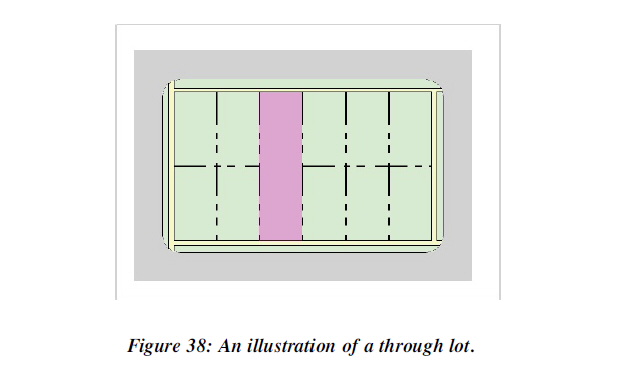 |
U.
Use. The specific purpose for which land or a building is designed, arranged, intended or for which it is or may be occupied or maintained. The term "permitted use" or its equivalent shall not be deemed to include any nonconforming use.
USGS. The United States Geological Survey.
V.
Variance. A grant of relief from certain standards of this Zoning Code.
W.
Wall Sign. Any building sign painted on, attached flush against, or extending not more than one (1) foot from an exterior wall in a parallel manner.
Window Sign. A permanent sign that is painted or mounted onto a windowpane, or that is hung directly inside a window.
Wireless Communications Facilities or WCF. Includes, but shall not be limited to, towers, poles, cables, wires, lines, wave guides, antennas, microwave dishes, and/or any other equipment or facilities associated with the transmission or reception of communications as regulated by the FCC (or other unregulated wireless communication facility). The term shall not include:
(a) Any satellite earth station antenna two (2) meters or less in diameter or diagonal measurement located in a non-residential district.
(b) Any satellite earth station antenna one (1) meter or less in diameter or diagonal measurement that is designed to receive direct broadband satellite service, including direct-to-home satellite services, or to receive or transmit fixed wireless signals via satellite regardless of zoning category.
(c) Any antenna that is one (1) meter or less in diameter or diagonal measurement and is designed to receive video programming service via broadband video services (wireless cable) or to receive or transmit fixed wireless signals other than via satellite.
(d) Any antenna that is designed to receive local television broadcast signals and does not use a mast higher than twelve (12) feet above the tallest point of the roof of the tallest principal or accessory structure, excluding chimneys, cupolas, or other architectural elements.
(e) Antennas used by amateur radio operators.
(f) Towers, structures, antennas, or other equipment used for the purposes of operating a public safety voice or data radio network or an outdoor early warning system within the City limits. This includes directional and omnidirectional antenna equipment, as well as microwave and point-to-point equipment.
X.
None.
Y.
None.
Z.
Zone. See District.
Zoning Code. The current zoning ordinance of the City.
(Ord. 2022-110. Passed 12-12-22.)
CODIFIED ORDINANCES OR PORTSMOUTH